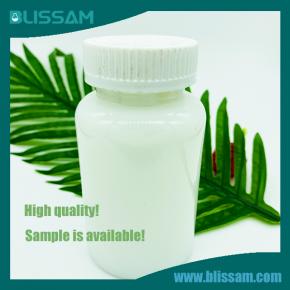Silicone emulsion is a type of emulsion that contains silicone as the dispersed phase and water as the continuous phase. Emulsions are mixtures of two immiscible liquids, where one is dispersed in the form of small droplets in the other. In silicone emulsions, the silicone droplets are uniformly dispersed in water, resulting in a stable and homogeneous mixture.
Types of Silicone Emulsions:
1. Non-ionic silicone emulsions: These emulsions do not contain any ionic groups and are stable in a wide range of pH levels. They are commonly used in personal care products such as shampoos, conditioners, and body lotions. 2. Anionic silicone emulsions: These emulsions contain negatively charged groups and are typically used in industrial applications such as coatings, adhesives, and sealants. 3. Cationic silicone emulsions: These emulsions contain positively charged groups and are commonly used in hair care products such as hair conditioners and styling products. 4. Amphoteric silicone emulsions: These emulsions contain both positively and negatively charged groups and are versatile in their applications. They can be used in both personal care and industrial products.
How to choose the right silicone emulsion:
1. Consider the intended use: Different types of silicone emulsions are designed for specific applications. For example, if you need an emulsion for personal care products, a non-ionic or cationic silicone emulsion would be suitable. 2. Compatibility with other ingredients: It is important to ensure that the silicone emulsion is compatible with other ingredients used in your formulation. This can be determined by conducting compatibility tests. 3. Stability: The emulsion should have good stability to prevent phase separation. This can be tested by storing the emulsion at different temperatures and observing for any changes. 4. Viscosity: The viscosity of the emulsion should be suitable for the intended application. Depending on the formulation, you may need a low or high viscosity emulsion. 5. Environmental considerations: It is important to consider the environmental impact of the silicone emulsion. Look for emulsions that are biodegradable and have low toxicity. 6. Supplier quality: Choose a reputable supplier who can provide a consistent and high-quality silicone emulsion. 7. Cost: Consider the cost of the emulsion, including shipping and handling costs, to ensure it fits your budget. However, do not compromise on quality for a lower price. choosing the right silicone emulsion is crucial for achieving the desired properties and performance in your product. By considering the factors mentioned above, you can select the most suitable silicone emulsion for your specific needs.

Say goodbye to tackiness and stickiness with our Silicone Emulsion. It is a non-toxic, non-corrosive, and environmentally friendly product that is perfect for personal care applications. Our emulsion can be used as a hair conditioner, adding shine, softness, and manageability to your locks. It also works as a skin moisturizer, leaving your skin smooth and hydrated.
Here are some frequently asked questions about Silicone Emulsion :
1. Can I apply Silicone Emulsion on wet surfaces?
It is not recommended to apply silicone emulsion on wet surfaces, as any excess water can cause dilution of the emulsion and impact its performance. It is best to apply the emulsion on dry surfaces for optimal results.
2. Does Silicone Emulsion offer UV resistance?
Yes, silicone emulsion offers excellent UV resistance and is commonly used in products or coatings with outdoor exposure. It can protect against UV degradation and improve the durability and lifespan of the end product.
3. What is the difference between silicone emulsion and silicone oil?
Silicone emulsion is a water-based dispersion of silicone oil, while silicone oil is a pure, concentrated form of silicone. Emulsion offers better stability and easier handling, while silicone oil provides a higher concentration of silicone for specific applications.
4. How can I remove Silicone Emulsion from surfaces?
Silicone emulsion can be easily removed from surfaces using a mild detergent and water. If the emulsion has cured, it can be scraped off with a plastic or wooden tool. It is important to avoid using harsh chemicals to avoid damaging the surface.
5. Does Silicone Emulsion require any special application equipment?
No, silicone emulsion can be applied using standard equipment such as sprayers, brushes, or dipping tanks. However, it is important to clean the equipment after use to avoid any buildup or clogging.
6. Can I use Silicone Emulsion on food-contact surfaces?
Silicone emulsion is not recommended for use on food-contact surfaces, as it is not approved for direct contact with food. It is important to only use approved and food-grade products for any application involving food.
7. Does Silicone Emulsion affect paint adhesion?
No, silicone emulsion does not affect paint adhesion. In fact, it can improve the adhesion of paint on surfaces such as glass, metal, and plastic. However, it is important to properly prepare the surface before painting to ensure optimal adhesion.
8. Can I use Silicone Emulsion for waterproofing?
Yes, silicone emulsion is commonly used for waterproofing in various industries. It provides excellent water repellency and can protect surfaces from water damage in both indoor and outdoor applications.
9. How does Silicone Emulsion improve the softness and feel of fabrics?
Silicone emulsion can improve the softness and feel of fabrics by reducing friction and increasing slip. It also enhances the drape and hand of the fabric, giving it a smoother and more luxurious feel.
10. What safety precautions should I take when using Silicone Emulsion?
When handling silicone emulsion, it is recommended to wear appropriate protective gear and follow the safety instructions provided by the manufacturer. Avoid contact with eyes and skin, and in case of accidental exposure, wash with water and seek medical attention if necessary.
11. Can I color Silicone Emulsion?
Yes, silicone emulsion can be colored using compatible dyes. It is important to consult with the manufacturer for recommendations and guidelines for achieving the desired color and shade.
12. Does Silicone Emulsion have any effect on metal surfaces?
Silicone emulsion is compatible with most metal surfaces and does not affect their properties. However, it is important to consult with the manufacturer for specific recommendations and guidelines for your application.
13. Is Silicone Emulsion resistant to chemical degradation?
Yes, silicone emulsion is highly resistant to chemical degradation, making it a preferred choice for applications where it may come in contact with chemicals. It is important to consult with the manufacturer for specific recommendations and guidelines for your application.
14. Can I use Silicone Emulsion as a lubricant?
Yes, silicone emulsion can be used as a lubricant for various applications such as machinery, metalworking, and automotive. It provides excellent high-temperature performance and can reduce friction and wear.
15. Is Silicone Emulsion heat curable?
Some silicone emulsions are heat curable, meaning they can form a thin, heat-resistant layer upon exposure to high temperatures. It is important to consult with the manufacturer to determine the appropriate curing conditions for your specific emulsion.
16. Can I use Silicone Emulsion for 3D printing?
Yes, silicone emulsion can be used as a release agent for 3D printing. It can be applied to the printing surface to prevent adhesive build-up and assist in the easy extraction of the printed object.
Contact:
Phone: +86-15957191858
E-mail: info@blissam.com
Whatsapp:+8615957191858
Add: A647, No. 9, Xiyuan Road, Xihu District, Hangzhou, Zhejiang, China
We chat
